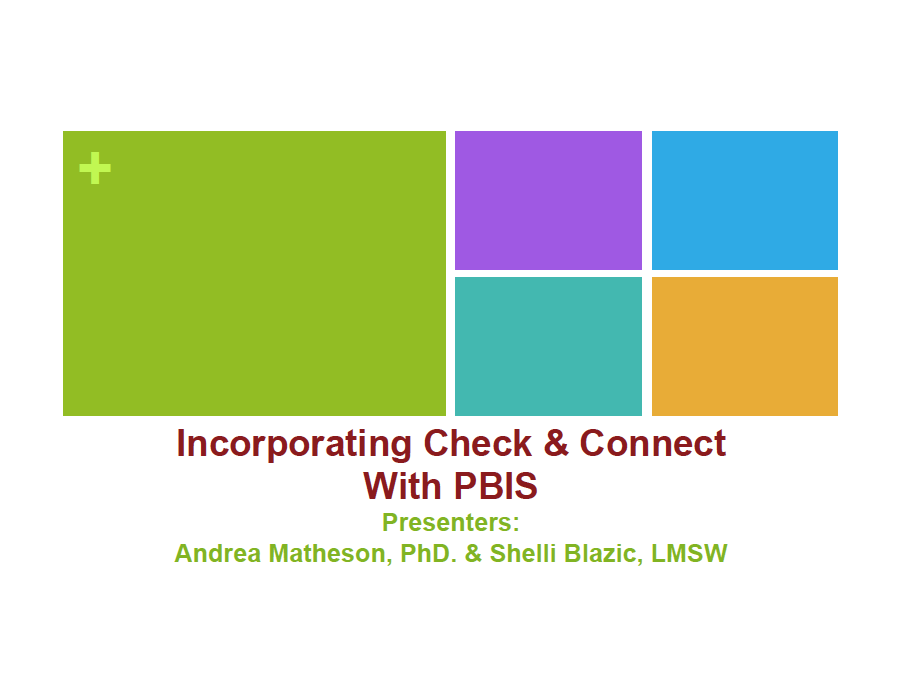

Main navigation | Main content

The following concurrent sessions – one of four themed tracks – took place at Check & Connect's first national conference, and slides from specific sessions are available below.
Kay A. Augustine, Ed.D., Youth & Adult Engagement Manager, Eastern Carver County Schools, MN
Erin Indrelie Swoboda, Administrative Dean, Chanhassen High School, MN
Stephen Pettinelli, Targeted Services District Coordinator, Burnsville Area Learning Center, MN
Cannot afford to hire mentors? Come learn how Minnesota School districts Eastern Carver County Schools and Eagan, Burnsville, Savage Public Schools are engaging AmeriCorps Promise Fellows, administrators, teachers, and staff to implement Check & Connect in grades K-12. We’ll share the implementation process, structure, funding streams, benefits, impact, and challenges, including strategies for getting everyone board.
View PDF of Presentation and Handouts
Daniel N. Samuta, Check & Connect Mentor, Cluster 5 RTLB, Auckland, New Zealand
Arthur Mui, Check & Connect Mentor, Cluster 5 RTLB, Auckland, New Zealand
Currently under the Positive Behaviour 4 Learning (PB4L) initiative for the Ministry Of Education in New Zealand, Check & Connect has been involved with two secondary schools in West Auckland for six months. With over 80% of Daniel and Arthur's referrals having a link to the Pacific Islands, this presentation focuses on how they have implemented Check & Connect by using a "Village Approach" to effectively work with Pacific Island families to address drop out.
Andrea Matheson, Ph.D., School Psychologist, Heartland Area Education Agency
Shelli Blazic, SSW, PBIS Coordinator, Great Prairie Area Education Agency
With the support of the state PBIS consultant, a total of 16 trainers representing all nine Iowa Area Education Agencies (AEA) began the process of becoming certified Check & Connect trainers in March 2014. This session will describe how Check & Connect is currently being supported at the state and AEA level as a tiered intervention for PBIS. Find out how Iowa AEA Check & Connect certified trainers are meeting the needs of their member districts to support the implementation of Check & Connect.
 View PDF of Presentation | Download PDF of Handout (School Readiness Indicators)
View PDF of Presentation | Download PDF of Handout (School Readiness Indicators)
Rebecca Phillpott,, Program Manager, San Diego Unified School District
Brisa Rodriguez, Check & Connect Mentor, San Diego Unified School District
Implementing Check & Connect with fidelity takes a committed mentor team led by an effective coordinator. The relationship of the coordinator to the mentors aligns with that of the mentor-student relationship; the coordinator is a persistent source of team motivation, guidance and monitoring to provide program consistency. Strategies learned in San Diego for program oversight, mentor supervision, caseload assignment, data monitoring, professional development and more will be shared.
Dennis W. Olson Jr., M.Ed., Director, Office of Indian Education, Minnesota Department of Education
As essential component of Check & Connect is working with families to support their student's engagement in education. Nowhere is supporting family members who support their children in school more important than in the American Indian community. Relationships are key and the ability to create a welcoming environment in public school can be very challenging. This presentation will describe how American Indian home school liaisons create a bridge between school and family in Minnesota and how these strategies may be transferable to other cultures as well.